供应链管理第12章 供应链绩效管理
- 格式:ppt
- 大小:602.50 KB
- 文档页数:28
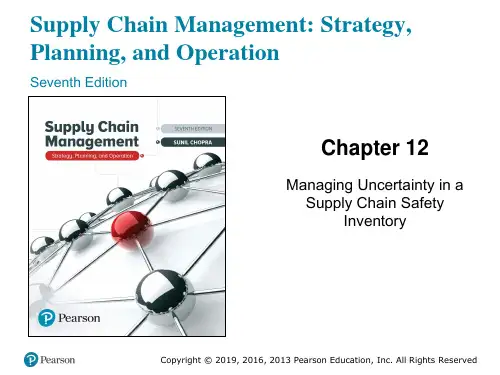
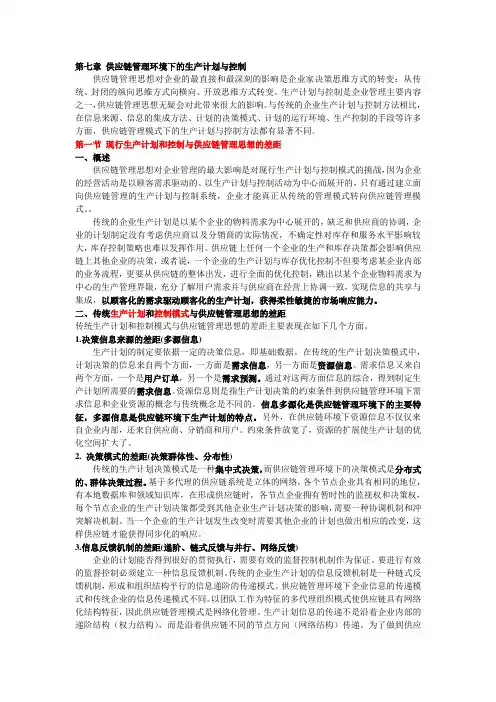
第七章供应链管理环境下的生产计划与控制供应链管理思想对企业的最直接和最深刻的影响是企业家决策思维方式的转变:从传统、封闭的纵向思维方式向横向、开放思维方式转变。
生产计划与控制是企业管理主要内容之一,供应链管理思想无疑会对此带来很大的影响。
与传统的企业生产计划与控制方法相比,在信息来源、信息的集成方法、计划的决策模式、计划的运行环境、生产控制的手段等许多方面,供应链管理模式下的生产计划与控制方法都有显著不同。
第一节现行生产计划和控制与供应链管理思想的差距一、概述供应链管理思想对企业管理的最大影响是对现行生产计划与控制模式的挑战,因为企业的经营活动是以顾客需求驱动的、以生产计划与控制活动为中心而展开的,只有通过建立面向供应链管理的生产计划与控制系统,企业才能真正从传统的管理模式转向供应链管理模式。
传统的企业生产计划是以某个企业的物料需求为中心展开的,缺乏和供应商的协调,企业的计划制定没有考虑供应商以及分销商的实际情况,不确定性对库存和服务水平影响较大,库存控制策略也难以发挥作用。
供应链上任何一个企业的生产和库存决策都会影响供应链上其他企业的决策,或者说,一个企业的生产计划与库存优化控制不但要考虑某企业内部的业务流程,更要从供应链的整体出发,进行全面的优化控制,跳出以某个企业物料需求为中心的生产管理界限,充分了解用户需求并与供应商在经营上协调一致,实现信息的共享与集成,以顾客化的需求驱动顾客化的生产计划,获得柔性敏捷的市场响应能力。
二、传统生产计划和控制模式与供应链管理思想的差距传统生产计划和控制模式与供应链管理思想的差距主要表现在如下几个方面。
1.决策信息来源的差距(多源信息)生产计划的制定要依据一定的决策信息,即基础数据。
在传统的生产计划决策模式中,计划决策的信息来自两个方面,一方面是需求信息,另一方面是资源信息。
需求信息又来自两个方面,一个是用户订单,另一个是需求预测。
通过对这两方面信息的综合,得到制定生产计划所需要的需求信息。
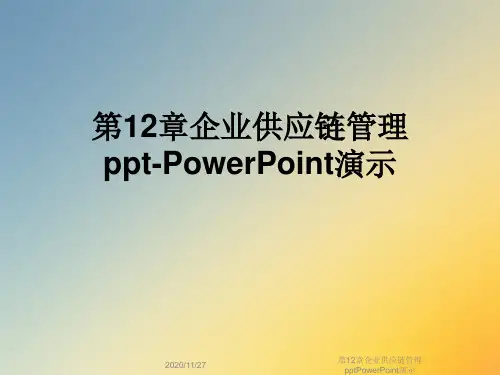
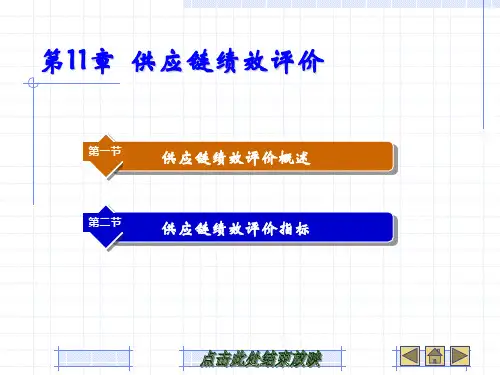
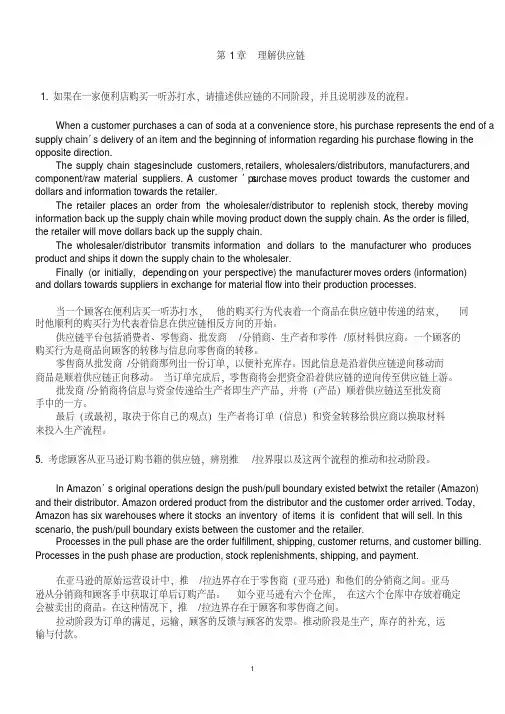
第1章理解供应链1. 如果在一家便利店购买一听苏打水,请描述供应链的不同阶段,并且说明涉及的流程。
When a customer purchases a can of soda at a convenience store, his purchase represents the end of a supply chain’s delivery of an item and the beginning of information regarding his purchase flowing in the opposite direction.The supply chain stages i nclude customers, retailers, wholesalers/distributors, manufacturers, andpurchase moves product towards the customer and component/raw material suppliers. A customer’sdollars and information towards the retailer.The retailer places an order from the wholesaler/distributor to replenish stock, thereby moving information back up the supply chain while moving product down the supply chain. As the order is filled,the retailer will move dollars back up the supply chain.The wholesaler/distributor transmits information and dollars to the manufacturer who produces product and ships it down the supply chain to the wholesaler.Finally (or initially, depending on your perspective) the manufacturer moves orders (information)and dollars towards suppliers in exchange for material flow into their production processes.当一个顾客在便利店买一听苏打水,他的购买行为代表着一个商品在供应链中传递的结束,同时他顺利的购买行为代表着信息在供应链相反方向的开始。
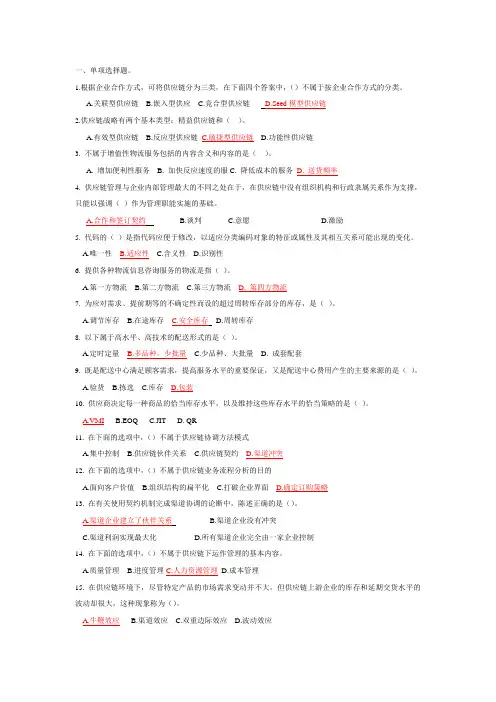
一、单项选择题。
1.根据企业合作方式,可将供应链分为三类,在下面四个答案中,()不属于按企业合作方式的分类。
A.关联型供应链B.嵌入型供应C.竞合型供应链D.Seed模型供应链2.供应链战略有两个基本类型:精益供应链和()。
A.有效型供应链B.反应型供应链C.敏捷型供应链D.功能性供应链3. 不属于增值性物流服务包括的内容含义和内容的是()。
A. 增加便利性服务B. 加快反应速度的服C. 降低成本的服务D. 送货频率4. 供应链管理与企业内部管理最大的不同之处在于,在供应链中没有组织机构和行政隶属关系作为支撑,只能以强调()作为管理职能实施的基础。
A.合作和签订契约B.谈判C.意愿D.激励5. 代码的()是指代码应便于修改,以适应分类编码对象的特征或属性及其相互关系可能出现的变化。
A.唯一性B.适应性C.含义性D.识别性6. 提供各种物流信息咨询服务的物流是指()。
A.第一方物流B.第二方物流C.第三方物流D. 第四方物流7. 为应对需求、提前期等的不确定性而设的超过周转库存部分的库存,是()。
A.调节库存B.在途库存C.安全库存D.周转库存8. 以下属于高水平、高技术的配送形式的是()。
A.定时定量B.多品种,少批量C.少品种、大批量D. 成套配套9. 既是配送中心满足顾客需求,提高服务水平的重要保证,又是配送中心费用产生的主要来源的是()。
A.验货B.拣选C.库存D.包装10. 供应商决定每一种商品的恰当库存水平,以及维持这些库存水平的恰当策略的是()。
A.VMIB.EOQC.JITD. QR11. 在下面的选项中,()不属于供应链协调方法模式A.集中控制B.供应链伙伴关系C.供应链契约D.渠道冲突12. 在下面的选项中,()不属于供应链业务流程分析的目的A.面向客户价值B.组织结构的扁平化C.打破企业界面D.确定订购策略13. 在有关使用契约机制完成渠道协调的论断中,陈述正确的是()。
A.渠道企业建立了伙伴关系B.渠道企业没有冲突C.渠道利润实现最大化D.所有渠道企业完全由一家企业控制14. 在下面的选项中,()不属于供应链下运作管理的基本内容。
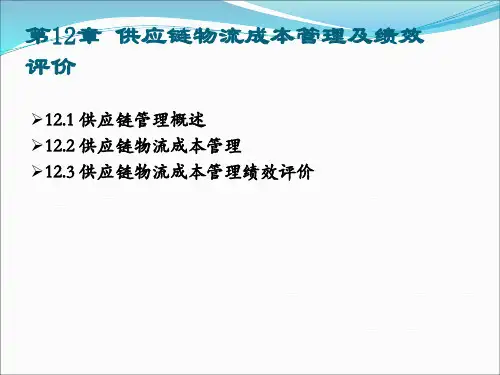

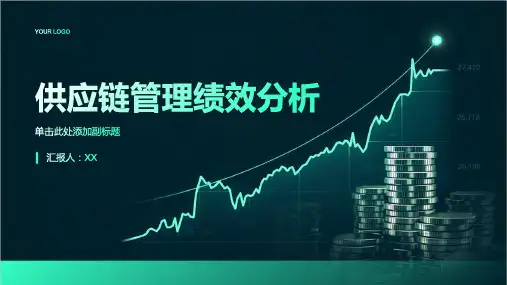
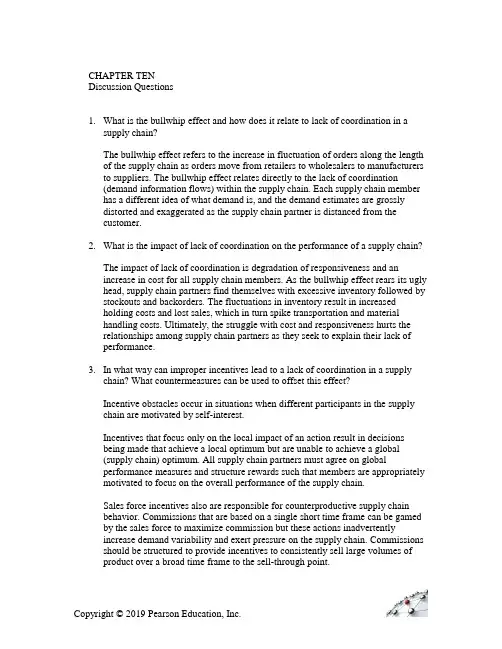
CHAPTER TENDiscussion Questions1.What is the bullwhip effect and how does it relate to lack of coordination in asupply chain?The bullwhip effect refers to the increase in fluctuation of orders along the length of the supply chain as orders move from retailers to wholesalers to manufacturers to suppliers. The bullwhip effect relates directly to the lack of coordination(demand information flows) within the supply chain. Each supply chain member has a different idea of what demand is, and the demand estimates are grosslydistorted and exaggerated as the supply chain partner is distanced from thecustomer.2.What is the impact of lack of coordination on the performance of a supply chain?The impact of lack of coordination is degradation of responsiveness and anincrease in cost for all supply chain members. As the bullwhip effect rears its ugly head, supply chain partners find themselves with excessive inventory followed by stockouts and backorders. The fluctuations in inventory result in increasedholding costs and lost sales, which in turn spike transportation and materialhandling costs. Ultimately, the struggle with cost and responsiveness hurts the relationships among supply chain partners as they seek to explain their lack of performance.3.In what way can improper incentives lead to a lack of coordination in a supplychain? What countermeasures can be used to offset this effect?Incentive obstacles occur in situations when different participants in the supply chain are motivated by self-interest.Incentives that focus only on the local impact of an action result in decisionsbeing made that achieve a local optimum but are unable to achieve a global(supply chain) optimum. All supply chain partners must agree on globalperformance measures and structure rewards such that members are appropriately motivated to focus on the overall performance of the supply chain.Sales force incentives also are responsible for counterproductive supply chain behavior. Commissions that are based on a single short time frame can be gamed by the sales force to maximize commission but these actions inadvertentlyincrease demand variability and exert pressure on the supply chain. Commissions should be structured to provide incentives to consistently sell large volumes of product over a broad time frame to the sell-through point.Sales force incentives based on “sell-in” rather than “sell-thru” lead to product being pushed in the supply chain, thus increasing forward buying. If possible, it is best to offer incentives based on sell-thru or even sell-out (sales to end consumers) because such incentives eliminate all incentives for forward buying.4.What problems result if each stage of a supply chain views its demand as theorders placed by the downstream stage? How should firms within a supply chain communicate to facilitate coordination?If each stage of a supply chain views its demand as the orders placed by theirdownstream counterpart, the bullwhip effect is realized by the supply chain(especially when lead times are long). Each member develops a forecast that is based on something other than the true customer demand and hilarity ensues.Supply chain members should share point-of-sale (POS) data (or at a minimum their own sales data) so that all members are aware of the true customer demand for product. The beauty of data sharing requirements is that only aggregate POS data must be shared to mitigate the bullwhip effect; there is no need to sharedetailed POS data.5.What factors lead to a batching of orders within a supply chain? How does thisaffect coordination? What actions can minimize large batches and improvecoordination?Order batching is caused by a number of different factors. One mechanism is the price structure of TL and LTL shipment quantities; there is incentive to wait awhile to make sure that a TL shipment is achieved. A customer’s natural tendency to wait for a milestone, either real or perceived, can also cause batching.Customers may wait until Friday, Monday, the last or first day of the month, etc., just because that’s when they always have or because that event reminds them to order. Order batching also occurs because customers are aware of an impending price reduction and want to take advantage of it. Batching adversely affectssupply chain coordination because the supply chain will be starved for flow, then overwhelmed with demand.A supply chain can reconfigure their transportation and distribution system toallow for shipments to multiple customers on a single truck to achieve TLquantities. The chain can also assign (or encourage) days for placing orders and move from lot-size based to volume based quantity discounts (or abandondiscounts and promotions altogether).6.How do trade promotions and price fluctuations affect coordination in a supplychain? What pricing and promotion policies can facilitate coordination?Trade promotions and price fluctuations make supply chain coordination more difficult. Customers seek to purchase goods for less and engage in forward buying which creates spikes in demand that may exceed capacity. All parties wouldbenefit if the supply chain used everyday low pricing (EDLP) to mitigate forward buying and allow procurement, production, and logistics to function at a steadier pace. If price incentives must be offered, the chain is better served byimplementing a volume-based quantity discount plan instead of a lot size based quantity discount, that is, providing incentives to purchase large quantities over a long period of time, perhaps a year. Forward buying can also be reduced ifpromotions are linked to sell-thru rather than the quantity purchased by a retailer.7.How is the building of strategic partnerships and trust valuable within a supplychain?Cooperation and trust within the supply chain help improve performance for the following reasons:•When stages trust each other, they are more likely to take the other party’s objectives into consideration when making decisions, thereby facilitatingwin–win situations.•Action-oriented managerial levers to achieve coordination become easier to implement and the supply chain becomes more agile.•An increase in supply chain productivity results, either by elimination of duplicated effort or by allocating effort to the appropriate stage.•Detailed sales and production information is shared; this allows the supply chain to coordinate production and distribution decisions.8.What are the different CPFR scenarios and how do they benefit supply chainpartners?Collaborative planning, forecasting, and replenishment (CPFR) is defined as a business practice that combines the intelligence of multiple partners in theplanning and fulfillment of customer demand. In order to be successful, the two parties must have synchronized their data and established standards forexchanging the information. The four scenarios that sellers and buyers cancollaborate along include:•Retail event collaboration—the identification of specific SKUs that will be involved in sales promotions and sharing of information regarding thetiming, duration, pricing, advertising, and display tactics to be deployed.The benefit of retail event collaborations is a reduction in stockouts,excess inventory, and unplanned logistics costs.•DC replenishment collaboration—the forecasting of DC withdrawals or demand from the DC to the manufacturer is converted to a stream oforders that are locked in over a specified time horizon. A successful DC replenishment collaboration reduces production costs at the manufacturer and inventory and stockouts at the retailer.•Store replenishment collaboration—the forecasting of store-level orders that are committed over a specific time horizon. Such a collaborationresults in greater visibility of sales for the manufacturer, improvedreplenishment accuracy and product availability, and reduced inventories. •Collaborative assortment planning—the forecasting (collaborative interpretation) of industry trends, macroeconomic factors, and customer tastes for seasonal goods. This forecast is converted into a plannedpurchase order at the style/color/size level that is used to produce sample products for a fashion event before final merchandising decisions aremade. The manufacturer benefits from this collaboration by having more lead time to purchase raw materials and plan capacity.•。
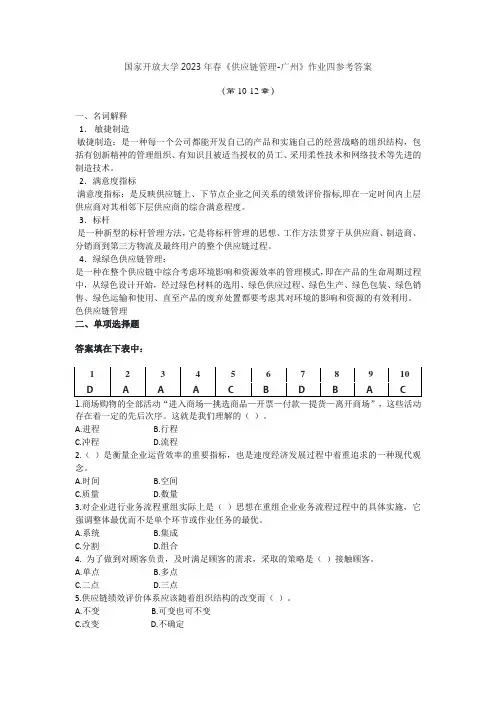
国家开放大学2023年春《供应链管理-广州》作业四参考答案(第10-12章)一、名词解释1.敏捷制造敏捷制造:是一种每一个公司都能开发自己的产品和实施自己的经营战略的组织结构,包括有创新精神的管理组织、有知识且被适当授权的员工、采用柔性技术和网络技术等先进的制造技术。
2.满意度指标满意度指标:是反映供应链上、下节点企业之间关系的绩效评价指标,即在一定时间内上层供应商对其相邻下层供应商的综合满意程度。
3.标杆是一种新型的标杆管理方法,它是将标杆管理的思想、工作方法贯穿于从供应商、制造商、分销商到第三方物流及最终用户的整个供应链过程。
4.绿绿色供应链管理:是一种在整个供应链中综合考虑环境影响和资源效率的管理模式,即在产品的生命周期过程中,从绿色设计开始,经过绿色材料的选用、绿色供应过程、绿色生产、绿色包装、绿色销售、绿色运输和使用、直至产品的废弃处置都要考虑其对环境的影响和资源的有效利用。
色供应链管理二、单项选择题答案填在下表中:存在着一定的先后次序。
这就是我们理解的()。
A.进程B.行程C.冲程D.流程2.()是衡量企业运营效率的重要指标,也是速度经济发展过程中着重追求的一种现代观念。
A.时间B.空间C.质量D.数量3.对企业进行业务流程重组实际上是()思想在重组企业业务流程过程中的具体实施,它强调整体最优而不是单个环节或作业任务的最优。
A.系统B.集成C.分割D.组合4. 为了做到对顾客负责,及时满足顾客的需求,采取的策略是()接触顾客。
A.单点B.多点C.二点D.三点5.供应链绩效评价体系应该随着组织结构的改变而()。
A.不变B.可变也可不变C.改变D.不确定6.目前比较流行使用的绩效评价指标主要是()分析。
A.事前B.事后C.事前和事后D.事前或事后7.标杆法是美国()公司确立的经营分析手法。
A.沃尔玛B.微软C.通用D.施乐8.()是指在产品制造过程中对环境的影响负作用最小,资源效率最高。
(更新版)国家开放大学电大专科《供应链管理》判断题问答题题库及答案(试卷号:2302)国家开放大学电大专科《供应链管理》判断题问答题题库及答案(试卷号:2302)盗传必究一、判断题(×)1.供应链管理是物流一体化的另外一种说法。
(×)2.合作伙伴关系有可能受到团队中强势群体的操控,但这并不影响弱势伙伴潜能的发挥。
(√)3.QR和ECR都重视供应链的核心业务,对业务进行重新设计,以消除资源的浪费。
(×)4.供应链合作就意味着只能使用单一供应源。
(√)5.ERP应用成功意味着企业的业务流程已趋于合理化了。
(√)6.在供应链管理环境下,企业的生产计划编制过程具有纵向和横向的信息集成过程的特点。
(×)7.库存在应付需求不确定性时有其积极的作用,但是库存又是一种资源浪费,应该无条件地实施零库存。
(√)8.缺货成本是指发生缺货时所带来的销售额损失及顾客的良好愿望损失,它是在一个订货完成周期内的预期缺货量与单位缺货成本与年订货次数的乘积。
(√)9.再订货点是用来明确启动补给订货策略时的货品单位数。
(×)10.供应链节点企业产需率指标越接近于1,说明上、下层节点企业之间的供需关系不协调,准时交货率低。
(√)11.绿色供应链管理包括从产品设计到最终回收的全过程。
(×)12.供应链绩效评价只有定量指标,没有定性指标。
(√)13.供应链中各企业的管理理念、管理方法和企业文化均不相同j所以供应链成员对供应链管理必然持不同态度,认识水平参差不齐。
(√)14.供应链的节点企业可能分布在本国的不同地方,也可能分布在世界各地。
(√)15.供应链管理强调的不只是供应环节,而是产品整个生命周期的所有环节。
(×)16.在市场经济时代,企业关注的焦点逐渐由过去关注客户转移到关注产品上来。
(×)17.在供应链管理环境下,采购部门的主要工作是将生产计划系统的采购计划转换为需求信息,以电子订单的形式传达给下游企业。
供应链管理-复习题一、填空题(每空1分,共xx分)第x章供应链生产管理1.供应链管理环境下生产计划编制的影响因素包括柔性约束、生产进度和生产能力。
2.供应链的协调控制根据协调的职能可划分为两类:不同职能活动之间集成协调和根据同一职能不同层次活动的协调。
3.供应链管理中生产计划的信息组织与决策有开放、动态、群体、集成和分散。
4.在供应链管理下跟踪机制的外部运行环境下的企业间的信息集成主要从采购和销售部门、制造部门、和生产计划部门3个部门展开。
5.对主生产计划进行外包分析,可将订单分解为外包子订单和自制件子订单。
6.在产品种类激增的背景下,延迟作为推迟产品差异的策略有两种形式:时间延迟和形式延迟。
7.通常将供应链结构划分为:拉式和推式两种。
8.分离点的定位与延迟活动的规模、延迟类型、顾客化方式均有密切关系。
第x章供应链信息管理1.给出对应的汉语翻译:ERP 企业资源计划、WMS 仓储管理系统。
2.ECR系统应用的主要信息技术有电子数据交换EDI 和销售时点信息POS 。
3.EAN 码是当今世界上广为使用的商品条码。
4.2005年国际电信联盟把物联网定义为一个4A网络,即任何时间、任何地点、任何人及任何物的联网。
第x章供应链绩效管理第x章供应链决策管理1.在制定供应链决策,特别是在设计全球供应链时,管理者除了要考虑供给和需求的不确定性因素之外,还要考虑其他影响上述决策的财务因素。
2.现金流的现值是指资金按规定的折现率,折算成现在或指定起始日期的数值。
3.贴现现金流量分析的前提是今天的货币价值高于未来的货币价值。
4.回报率k也称为贴现率或资本的机会成本。
5.贴现现金流量的决策树可以用来评估在价格、需求、汇率以及通货膨胀等因素不确定的情况下所作出的供应链决策。
6.“数据-模型-知识”(DMK)构架是侧重于制定决策所需要的投入,它把决策投入分为数据、模型、和知识三类。
7.常用的决策技术有:数学最优化技术、仿真技术、数学规划技术、基于约束的技术、基于结构的方法、人工智能AI 、专家系统ES 。
名词解释1.供应链的概念:供应链是围绕企业,通过对信息流、物流、资金流的控制,从采购原材料开始,制成中间产品以及最终产品,最后由销售网络把产品运送到消费者手中的,将供应商、制造商、分销商、零售商直到最终用户连成一个整体的功能网链结构模式。
2.供应链管理:是同一供应链上的所有节点企业,包括供应商、分销商、零售商等,将所处的供应链中的各种资源进行集成,并对供应链中的各种运作进行同步化、集成化管理,从而形成高度竞争力,使得该供应链的产品在快速多变的市场中处于优势地位的一种管理模式。
3. 有效性供应链:体现供应链的物理功能,即以最低的成本将原材料转化成零部件、半成品、产品,以及在供应链中的运输等;反应性供应链:体现供应链市场中介的功能,即把产品分配到满足用户需求的市场,对未预知的需求做出快速反应等推动模式:是传统的供应链模式,指根据商品的库存情况,有计划地将商品推销给客户。
拉动式模式:消费者是供应链的开端,因此也叫需求驱动模式。
4.物流:即以最高效率和最大成本效益,以满足顾客需要为目的,从商品的生产地点到消费地点,包括原材料、在制品、最终成品及其相关信息的流动与储存,进行设计、实施和控制的过程。
5.联合的物流计划系统:为了更好地供应链物流业务过程的总体计划,需要对每一作业流程进行计划,因此要有供应链计划系统、库存计划系统和运输计划系统。
这些计划系统被称为联合的物流计划系统。
6.物流网络:是由固定的物流设施(如配送中心、码头、仓库等运输线路和信息)组成的具有物流能力的物流结构。
7.逆向物流:是商品退货、回收和废弃物流。
社会物流:企业外部的物流活动的总称,为社会物流。
社会物流一般指流通领域所发生的物流,是全社会物流的整体,所以有时被称为大物流或宏观物流。
供应物流:是指物资生产者、持有者至使用者之间的物流,即为生产企业提供原材料、零部件或其他物品时,物品在提供者与需求者之间的实体流动。
销售物流:指生产企业、流通企业出售产品时,物品在供方与需方之间的实体流动。
运营供应链管理复习提纲第一章全球经济一体化及市场竞争特征◆“纵向一体化”管理模式的弊端◆横向一体化(horizontal integration)思想◆供应链的定义◆在一个供应链系统中,有一个企业处于核心地位,它可以是制造型企业,也可以是零售型企业◆供应链是一个网链结构,节点企业和节点企业之间是一种需求与供应关系.◆供应链的主要特征◆供应链管理的概念◆推动式和拉动式供应链第二章供应链管理基础理论◆供应链管理主要涉及六个主要领域◆供应链管理的目标在于提高用户服务水平和降低总的交易成本,并且寻求这两个目标之间的平衡。
◆供应链管理基本职能领域和辅助职能领域◆供应链管理与传统管理模式的区别◆供应链的类型:稳定型和动态型;平衡型和失衡型;效率型和响应型;敏捷性供应链◆根据产品的客户需求模式将产品分类:功能性产品、创新性产品◆“推—拉”结合的供应链:戴尔计算机第三章供应链的构建与优化◆供应链构建的设计原则◆贯彻供应链拓扑结构的三种形式◆子网模型对企业集团是很好的描述◆供应链网络的结构特征第四章供应链运作的协调管理◆牛鞭效应,即需求变异放大现象◆供应链中需求变异放大产生的原因是什么?◆缓解牛鞭效应的方法第五章供应链合作伙伴选择与评价◆供应链合作伙伴关系◆根据合作伙伴在供应链中的增值作用和他的竞争实力,合作伙伴的分类◆选择合作伙伴时考虑的主要因素,我国选择合作伙伴的主要标准◆合作伙伴选择的常用方法◆客户关系管理的理解第六章供应链物流管理◆物流的概念◆物流管理在供应链管理中的作用◆供应链环境下物流管理的特点◆物流业务外包的优势◆第三方物流的概念◆在供应链管理中,通过第三方物流可以使得供应链管理的利益第七章供应链管理环境下的库存控制◆库存的概念◆单周期需求的概念◆四种库存补给策略◆传统库存控制的特点◆VMI的概念◆VMI实施中应坚持的原则◆VMI的形式有哪几种?◆联合库存管理是一种风险分担的库存管理模式◆联合库存管理的概念◆联合库存管理的优点◆联合库存管理的实施方法◆供应链的库存成本结构◆多级库存控制的方法◆敏捷制造是一种基于时间优化的多级库存控制策略第八章供应链管理环境下的采购管理◆在评价供应商时价格不是主要的因素,质量是最重要的标准◆传统采购模式存在的问题◆传统采购与供应链管理模式下采购的区别◆准时化采购的特点◆准时采购的基本原则◆双赢关系对于采购中供需双方的作用表现◆试述全球采购对中国企业的影响第九章供应链管理环境下的生产计划与控制◆CPFR的概念◆简述CPFR实施中的关键因素◆实现延迟化策略的关键技术是模块化第十章供应链管理下的企业组织设置与运行管理◆BPR的概念第十一章供应链管理绩效评价◆供应链绩效评价的原则◆SCOR从三个方面进行评价◆平衡计分卡的概念◆平衡计分法的四个主要特征第十二章供应链管理与信息技术◆供应链可视性的概念第十三章供应链风险管理◆供应链风险的概念◆供应链风险管理的主要目标◆供应链风险的特点运营供应链管理例题一、单项选择题1。